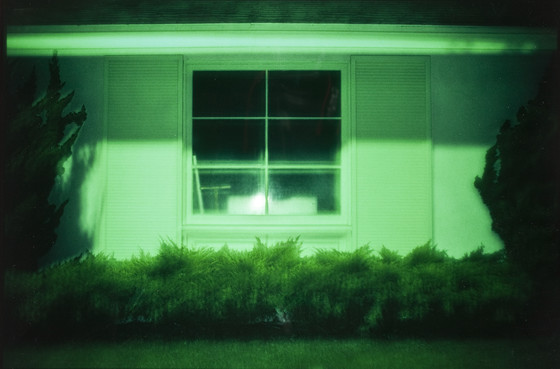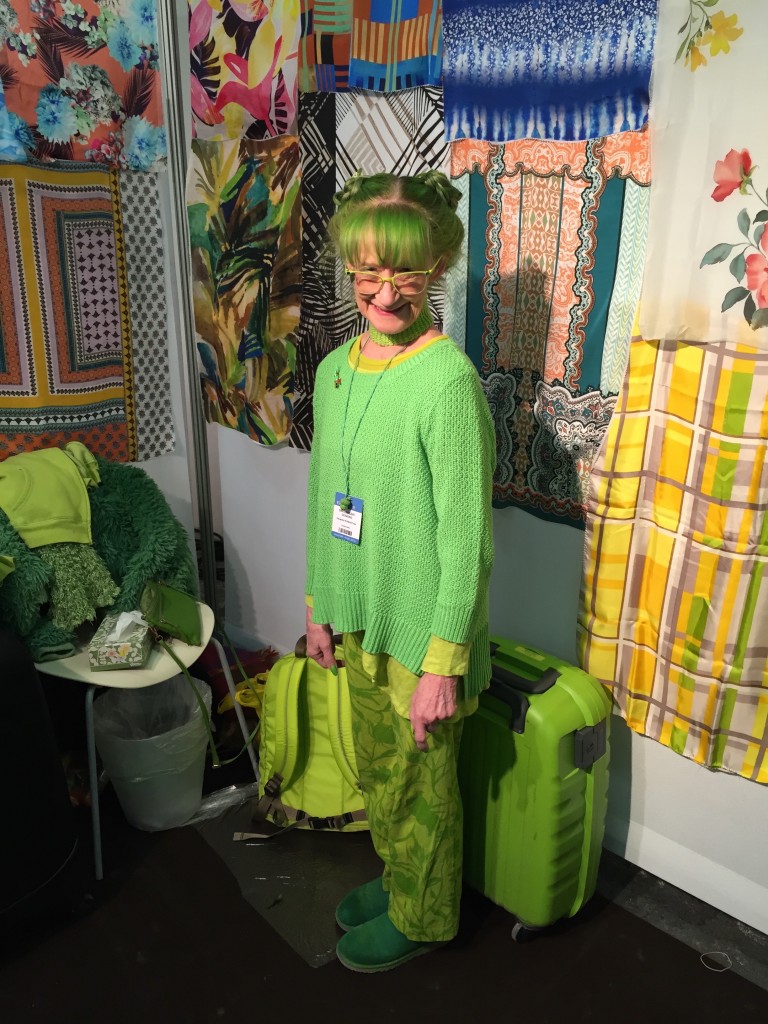
This article is the second in a series of interviews about dressing in monochrome.
COLOUR IS THE FIRST THING you notice about Elizabeth Sweetheart Rosenthal. When we meet on a Saturday afternoon at her home in Brooklyn, the seventy-six-year-old is wearing algae mascara, pea overalls, and clogs spray-painted grass. They match her walls, carpet, picture frames and hair. Her iPad is tiled with sticker frogs. She serves lunch, tomatoes from her backyard garden, on a moss-coloured plate.
We ignore the obvious at first. Elizabeth and her husband Robert pull out giant rolls of watercolour paper. They are illustrations for fashion and home furnishing prints: lilies and beetles destined for suburban sofas, a toile of a L.L. Bean boot, a soft-focus Ralph Lauren polo player. On many, the colours have yet to be filled in. After the Eighties, computers began doing that kind of work much more quickly, the artists working in Elizabeth’s Midtown studio moved on to other fields and Elizabeth ‘became green.’
She is almost famous. When Elizabeth goes outside, strangers ask for photographs, but she says she is afraid to ruin the freshness of the encounters by asking them to send her copies. To them, she is The Green Lady of Brooklyn, as seen in the New York Times and the New York Post and on the blog Humans of New York, a kind of leprechaun in real life. She loves people, but isn’t much of a talker. Robert, her partner of fifty years whose grey T-shirt is the only not-green thing in my field of vision, fills in the gaps.
***
Elizabeth Rosenthal: I hitchhiked to New York from Canada in 1964. My mom and dad were doctors and my father was against me becoming an artist. I was twenty-three.
Robert Rosenthal: We were both refugees from tremendous social pressure. At the time, you were either an outlaw, a hoodlum type, or you totally conformed. There was no in-between. Living in the city there were bohemians…
Elizabeth: I was a beatnik!
Robert: For a while, her parents sent the ‘Want’ ads from the local paper, like, hey, there’s all these opportunities back here. Her first job in New York was in the garment centre. When she arrived, she was looking for an apartment and someone said, you have to find a job first. She said, how do you get a job?
Elizabeth: That’s how I’ve always worked! I was carrying a pillow and my sketchbook.
Robert: New York State had an employment service. The woman asked, What can you do? She said, I can draw. At the time, there were converters in the fashion industry. They were the middle men between mill and manufacturer, and they’d design a line on spec which they’d have artists work on by hand, then sell it to a manufacturer. The company would send her down to the mills in the South, to make sure the colours came out right. There were many more prints back then. Floral hankies, scarves, accessories. Everyone was doing these cute little conversational sets. Every design had colour combinations. Now there are virtually none; the industry is three, four percent of what it was. There’s a fashion and an economic reason. Clothes are simpler, and brands aren’t willing to waste money speculating.
Elizabeth: I started my own studio thirty years ago. Sweetheart is the name now. I’m Sweetheart, that’s what everyone calls me. In the Seventies it was Sweetpea. And I brought Robert in when I started. He’d go out and do all the shopping for me for vintage swatches, which we’d redo for brands. We’re both artists, too. I do little watercolours when I go to Canada.
Robert: What we would do is literally get garbage scraps and damaged things and then mount them and present them like art. We’d go to second-hand stores, junk places. These prints were in the public domain after a certain number of years, so you could sell them as a concept and then adapt them for the customer. Ralph Lauren always bought vintage. They’d buy 1930s and 1940s rayon shirts. So let’s say you have a little island with palm trees, you’d put three trees instead of two. And if you have a flower you put five petals instead of four. Polo gave her all their dogs, all their horses.
Elizabeth: The Polo logo now, the embroidery on their shirts, is from a horse we did.
Robert: One year for their showrooms, all the shoes that came in looked too new, so they sent us hundreds of pairs. We dipped them in tea, sand-papered them, dripped paint on them. We made a prototype for a pair of jeans, and the belt-buckles were too shiny, so we’d damage them. There was one year where we were damaging things full-time.
Elizabeth: No one knows we did all that. They paid me $6,000 for that one pair of jeans. Now they reuse the old designs.
Robert: We found a niche. There was so much work we couldn’t even complete it. And then it disappeared.

Elizabeth: I haven’t always been green. I went through different stages; at first it was vintage. I wore Thirties and Forties dresses. And then I started dying things myself, all nice bright colours, not just green, but different ones, pink, purple. I wore Bakelite, antique costume jewelry.
Robert: She used to get these big straw hats in the millinery district with artificial flowers.
Elizabeth: And then it was overalls. That was after the vintage stage, when I hit fifty. I would go to Gap Kids; they had great overalls in different colours.
Robert: She had black velvet overalls for formalwear.
Elizabeth: If I like it I do it!
Robert: The green has gotten brighter over time.
Elizabeth: When I was becoming green, I used to walk our dog in the neighbourhood. And we became part of the scenery and the children really loved it. People would come up to me. That’s why I kept it going for ten years.
Robert: Then the media started. It was a local article, by a lady from the neighbourhood. And then there was a New York Magazine article, the one with Lindsay Lohan as Marilyn Monroe. And the New York Times. Everybody read that. We got calls from Australia, Taiwan, Norway.
Elizabeth: I’m embarrassed!
Robert: The other day someone asked me if I’d figured out a way to monetise this. There are people who… for example, there’s a Pink Lady in Los Angeles. She’s definitely monetising. She’s always trying to get Elizabeth to appear in her videos.
Elizabeth: I don’t want to be paid to be me. I’m not a politician. You know what’s really funny about the video people, is they didn’t really care about me at all. It’s like I’m an object or something. They couldn’t have cared what I put on, or how I was feeling, or whether I was sad. They were doing their work of art.
Robert: She wouldn’t walk the dog until we got a green leash. She signs her checks in green. My underwear is green, because—
Elizabeth: I don’t separate them.
Robert: Hers is green, and mine starts white and then it becomes sort of yellow.
Elizabeth: It’s my life. To tell you the truth, I’m really green.
Robert: Some people shot some stupid things. You know, bought all the green juice for her to drink and put her on Central Park South and left her in the cold. And people would say, ‘Can I take a selfie with you?’ And [the film crew] would come running up and say, ‘Why are you talking to this lady?’ with their microphone in the face. Ninety-nine percent of the time it’s wonderful. But when she comes back from Manhattan sometimes she’s like, Oh, thank god. But then she says, I met so many lovely people.
Elizabeth: They always say, green’s my favourite colour too. But they’re wearing black. I really love people and I love their reactions.
Robert: New York has been absolutely magical. We came in just as one scene was ending and the next was starting. When Soho became the artist’s scene, the neighbourhood was empty on the weekend. You’d hear these loud noises from a couple blocks away and you could just follow the sound to a party.
Elizabeth: My mother died a couple years ago at one hundred and four, and she had macular degeneration. But she could see in her periphery and she could always see me. We’d go walking together. She loved me being green. I’ve had a long life and have been through a lot and have my design studio and this and that. But when people see me they just see the Green Lady. That’s fine.
Alice Hines is Vestoj’s online editor and a writer in New York City.